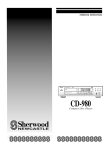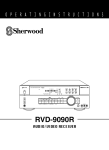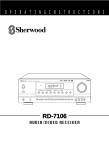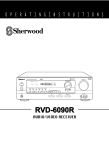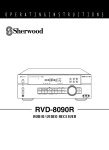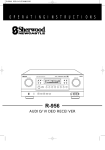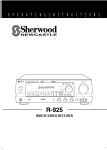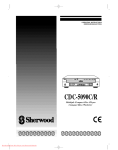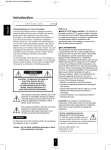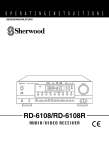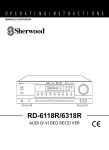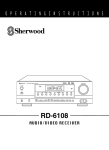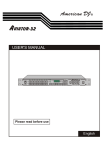Download Sherwood R-945 Troubleshooting guide
Transcript
O P E R A T I N G I N S T R U C T I O N S NEWCASTLE AUDIO/VIDEO RECEIVER R-945MKII MASTER VOLUME OSD VIDEO LABELS VCR 1 REC T.2 MONITOR STANDBY MULT I ROOM REMOTE SENSOR RF OPTICAL COAXIAL VCR1 REC CINEMA BASS DVD LDP AUX SOURCE DIGITAL Pro Logic POWER ST TAPE 2M TUNED AUTO MEMOTY PRESET INPUT SELECTOR/ INDEX 3 Stereo DSP THEATER HALL STADIUM CHURCH SLEEP SLEEP TUNING FREQ.DIRECT MEMO / ENTER 1 2 3 4 5 6 7 8 9 0 BAND DIGITAL INPUTS DTS DIGITAL PRO LOGIC SURROUND MODE FM MODE - REAR LEVEL + SPEAKER MODE - CENTER LEVEL + STEREO FRONT BASS PHONES TREBLE BALANCE AUX SPEAKER DYNAMIC RANGE CINEMA BASS ON/ AUX SEL OFF -10 10+ -10 10+ LEFT RIGHT R-945MKII AUDIO/VIDEO RECEIVER S-VIDEO VIDEO L _ AUDIO _ R Introduction ENGLISH UNPACKING AND INSTALLATION Congratulations on Your Purchase! Your new high fidelity receiver is designed to deliver maximum enjoyment and years of trouble free service. Please take a few moments to read this manual thoroughly. It will explain the features and operation of your unit and help ensure a trouble free installation. Please unpack your unit carefully. We recommend that you save the carton and packing material. They will be helpful if you ever need to move your unit and may be required if you ever need to return it for service. Your unit is designed to be placed in a horizontal position and it is important to allow at least two inches of space behind your unit for adequate ventilation and cabling convenience. To avoid damage, never place the unit near radiators, in front of heating vents, in direct sunlight, or in excessively humid or dusty locations. Connect your complementary components as illustrated in the following section. CAUTION RISK OF ELECTRIC SHOCK DO NOT OPEN CAUTION : TO REDUCE THE RISK OF ELECTRIC SHOCK, DO NOT REMOVE COVER (OR BACK). NO USER-SERVICEABLE PARTS INSIDE. REFER SERVICING TO QUALIFIED SERVICE PERSONNEL. This symbol is intended to alert the user to the presence of uninsulated "dangerous voltage" within the product's enclosure that may be of sufficient magnitude to constitute a risk of electric shock to persons. This symbol is intended to alert the user to the presence of important operating and maintenance (servicing) instructions in the literature accompanying the appliance. WARNING To reduce the risk of fire or electric shock, do not expose this appliance to rain or moisture. Caution : Do not block ventilation openings or stack other equipment on the top. 2 FOR U.S.A. Note to CATV System Installer: This reminder is provided to call the CATV system installer's attention to Article 820-40 of the NEC that provides guidelines for proper grounding and, in particular, specifies that the cable ground shall be connected to the grounding system of the building, as close to the point of cable entry as practical. FCC INFORMATION This equipment has been tested and found to comply with the limits for a Class B digital device, pursuant to Part 15 of the FCC Rules. These limits are designed to provide reasonable protection against harmful interference in a residential installation. This equipment generates, uses and can radiate radio frequency energy and, if not installed and used in accordance with the instructions, may cause harmful interference to radio communications. However, there is no guarantee that interference will not occur in a particular installation. If this equipment does cause harmful interference to radio or television reception, which can be determined by turning the equipment off and on, the user is encouraged to try to correct the interference by one or more of the following measures: Reorient or relocate the receiving antenna. Increase the separation between the equipment and receiver. Connect the equipment into an outlet on a circuit different from that to which the receiver is connected. Consult the dealer or an experienced radio/TV technician for help. CAUTION: Any changes or modifications in construction of this device which are not expressly approved by the party responsible for compliance could void the user's authority to operate the equipment. FOR U.S.A. AND CANADA ................................. 120 V FOR EUROPE AND AUSTRALIA ........ 230 V/240 V FOR YOUR SAFETY FOR YOUR SAFETY Units shipped to the U.S.A. and Canada are designed for operation on 120 V AC only. Units shipped to Australia are designed for operation on 240 V AC only. To ensure safe operation, the three-pin plug supplied must be inserted only into a standard threepin power point which is effectively earthed through the normal household wiring. Extension cords used with the equipment must be three-core and be correctly wired to provide connection to earth. Improper extension cords are a major cause of fatalities. The fact that the equipment operates satisfactorily does not imply that the power point is earthed and that the installation is completely safe. For your safety, if in any doubt about the effective earthing of the power point, consult a qualified electrician. PAN-EUROPEAN UNIFIED VOLTAGE All units are suitable for use on supplies 230-240 V AC. Safety precaution with use of a polarized AC plug. However, some products may be supplied with a nonpolarized plug. CAUTION : To prevent electric shock, match wide blade of plug to wide slot, fully insert. ATTENTION : Pour eviter les choc electriques, introduire la lame la plug large de la borne correspondante de la prise et poussre jusqu'au fond. CONTENTS Introduction UNPACKING AND INSTALLATION ......................................................................................................................... 2 READ THIS BEFORE OPERATING YOUR UNIT ..................................................................................................... 3 System Connections .............................................................................................................................................................. 4 Front Panel Controls ............................................................................................................................................................ 7 Universal Remote Control DIGI LINK SYSTEM REMOTE CONTROLS ............................................................................................................. 8 OPERATING COMPONENTS WITH REMOTE CONTROL ................................................................................... 10 REMOTE CONTROL OPERATION RANGE ............................................................................................................ 10 LOADING BATTERIES .............................................................................................................................................. 10 ENTERING A SET-UP CODE .................................................................................................................................... 11 Operations LISTENING TO A PROGRAM SOURCE ................................................................................................................... 12 SURROUND SOUND ...................................................................................................................................................14 ENJOYING SURROUND SOUND ............................................................................................................................. 15 LISTENING TO RADIO BROADCASTS .................................................................................................................. 20 AUDIO RECORDING ................................................................................................................................................. 22 RECORDING WITH VCR 1 ........................................................................................................................................ 23 OTHER FUNCTIONS .................................................................................................................................................. 25 Using the OSD CURRENT STATUS DISPLAY ................................................................................................................................... 27 MENU SCREEN ........................................................................................................................................................... 28 Troubleshooting Guide ....................................................................................................................................................... 30 Specifications ....................................................................................................................................................................... 31 3 ENGLISH READ THIS BEFORE OPERATING YOUR UNIT ENGLISH System Connections Do not connect the receiver to the wall AC outlet when plugging and unplugging connection cords. Be sure to connect the white RCA pin cords to the L (left) and the red RCA pin cords to the R (right) jacks when making connections. Change the position of the FM indoor antenna until you get the best reception of your favorite FM stations. A 75 Ω outdoor FM antenna may be used to further improve the reception. Disconnect the indoor antenna before replacing it with the outdoor one. Place the AM loop antenna as far as possible from the receiver, TV set, speaker cords and the AC input cord and set it to a direction for the best reception. If the reception is poor with the AM loop antenna, an AM outdoor antenna can be used in place of the AM loop antenna. Caution: When listening to AM broadcasts in a surround mode without an AM antenna, digital noise can be heard. Should this happen, connect an AM antenna. Make connections firmly and correctly. If not, it can cause loss of sound, noise or damage to the receiver. If the electricity fails or the AC input cord is left unplugged for about 2 weeks, the memorized contents will be cleared. Should this happen, memorize them again. ■ CONNECTING ANTENNAS L R S E R . NO ANTENN FM DIGITAL INPUTS MAIN IN AC INPUT ~120V/60Hz 4A PHONO AC-3 RF L R S-VIDEO VIDEO L PRE OUT MODEL NO. R-945MKII R E85649 CENTER SPEAKER (8Ω) 29Z3 LISTED AUDIO EQUIPMENT AUDIO/VIDEO RECEIVER PRE OUT (OUTDOOR ANTENNA) NEWCASTLE DVD L AM LOOP LDP C CENTER AC-3/PCM FM 75Ω TAPE 1 PLAY L Manufactured under license from Dolby FRONT Laboratories. "Dolby", "PRO LOGIC" and SPEAKERS (8Ω) the double-D symbol are trademarks of Dolby Laboratories. Confidential Unpublished Works. '1992-1997 Dolby Laboratories, Inc. All rights reserved. PLAY OPTICAL REAR PRE OUT VCR TAPE 1 REC REC TAPE 2 PLAY TV C MADE IN KOREA DESIGNED IN USA COAXIAL SUB WOOFER R L AC OUTLETS REAR SPEAKERS (8Ω) R R L GND MULTI ROOM TAPE 2 REC L T h i s d evice complies with Part 15 of the FCC Rules. Operation is subject to the following two conditions: (1)This device may not cause harmful interference, and (2)this device must accept any interference received, including interference that may cause undesired operation. FM DIGI-LINK VIDEO MONITOR C AUTION SWITCHED ~~120V/60Hz TOTAL 100W 1A MAX RISK OF ELECTRIC SHOCK D O N O T OPEN W ARNING:"SHOCK HAZARDDO NOT OPEN" AVIS:"RISQUE DE CHOCELECTRIQUE-NE PAS OUVRIR" ■ CONNECTING VIDEO COMPONENTS AM loop antenna (INDOOR ANTENNA) R "Manufactured under license from Digital Theater Systems, Inc. US Pat. No.5,451,942 and ather world-wide patents issues and pending. "DTS", "DTS Digital surround", are trademarks of Digital Theater systems, Inc. Copyright 1996 Digital Theater System, Inc. All Rights Reserved. Video deck 1 AUDIO IN POWER S-VIDEO IN MULTIPLE COMPACT DISC PLAYER CDC-5080R ON/OFF V-CD PBC GRAPHICS 1 OPEN/CLOSE 2 REVERT PEAK 3 PROG AUTO DELETE EDIT 4 A RANDOM SCENE TRACK INDEX B REPEAT ALL 1 DISC S A< >B MPX INTRO STEP 5 1 4 7 10 13 2 3 5 6 8 9 11 12 14 15 PHONES LEVEL PHONES MIN LD player 300 ohm feeder AUDIO OUT AM LOOP 1 2 3 4 5 S-VIDEO OUT VIDEO OUT AUDIO OUT S-VIDEO OUT DISC SKIP MULTIPLE COMPACT DISC PLAYER CDC-5080R OPEN/CLOSE PLAY EXCHANGE Play 1 Exchange 4 POWER ON/OFF 5 DISC AUTOMATIC DISC LOADING SYSTEM PHONES LEVEL REMOTE SENSOR V-CD PBC GRAPHICS 1 2 REVERT PROG PEAK 3 4 DELETE AUTO EDIT A RANDOM REPEAT ALL 1 DISC S A< >B MPX INTRO SCENE TRACK B INDEX STEP 5 1 4 7 10 13 VIDEO IN ANTENNA MAX PROGRAM/REVIEW RANDOM REPEAT MIN 2 3 5 6 8 9 11 12 14 15 MAX PHONES VIDEO OUT DVD player AUDIO OUT S-VIDEO OUT MULTIPLE COMPACT DISC PLAYER CDC-5080R POWER ON/OFF FM VIDEO OUT 75Ω SUPPLIED ADAPTOR L R VIDEO S-VIDEO DVD LDP ■ CONNECTING AUDIO COMPONENTS PLAY Turntable with MM type cartridge VCR CD player REC MULTIPLE COMPACT DISC PLAYER CDC-5080R OPEN/CLOSE V-CD PBC REVERT PROG GRAPHICS POWER PEAK DELETE ON/OFF 1 2 3 4 AUTO EDIT A B RANDOM REPEAT ALL 1 DISC S A< >B MPX INTRO SCENE TRACK INDEX STEP 5 1 2 3 4 5 6 7 8 9 10 11 12 13 14 15 PHONES LEVEL REMOTE SENSOR PROGRAM/REVIEW RANDOM REPEAT MIN MAX PHONES TV Tape deck 1 DIGI-LINK STEREO DOUBLE CASSETTE DECK DD-5080C RESET COUNTER A/B MODE BC HIGH NORM CD SYN M MPX MIN RELAY P T SIZE SEC MEMORY B/C/OFF DIGI-LINK REC REC R PLAY L dB -00 -20 -10 -6 -3 0 +3 REVERSE +6 R AUTO REVERSE DUBBING EJECT NORMAL POWER PHONES REC LEVEL 0 L AUTO REVERSE CD SUN REC AMS REC BALAMCE 10 L R A MIC MIX SOURCE VIDEO MONITOR Monitor TV HX-PRO RECORD & PLAY/AUTO TAPE SELECTOR MIC MIC R VIDEO IN PHONO O/O HIGH AMS B S-VIDEO IN PLAY/AUTO TAPE SELECTOR PLAY(LINE OUT) R L REC(LINE IN) CD *Tape deck 2 or graphic equalizer TAPE 1 PLAY DIGI-LINK STEREO DOUBLE CASSETTE DECK DD-5080C RESET COUNTER A/B MODE BC HIGH NORM CD SYN M MPX MIN RELAY P T SIZE SEC MEMORY REVERSE R PLAY -00 B/C/OFF REC REC L dB -20 -10 -6 -3 0 +3 +6 R AUTO REVERSE TAPE 1 REC EJECT DUBBING NORMAL PLAY/AUTO TAPE SELECTOR O/O POWER GND AMS PHONES REC LEVEL 0 TAPE 2 PLAY AUTO REVERSE CD SUN REC HIGH AMS B 10 REC BALAMCE L R A MIC MIX SOURCE HX-PRO RECORD & PLAY/AUTO TAPE SELECTOR MIC AUDIO OUT MIC VIDEO OUT * The TV jacks may also be connected to an additional video component such as a cable TV tuner, a video deck or satellite system. * Use the S-VIDEO jacks to make connections to video components with S-VIDEO IN/OUT jacks. A signal input into the S-VIDEO jack will be output in only the S-VIDEO jack and a signal input into the normal VIDEO jack will be output in only the normal VIDEO jack. PLAY(LINE OUT) TAPE 2 REC L R *TV or additional video component S-VIDEO OUT REC(LINE IN) * The TAPE 2 MONITOR PLAY/REC jacks may also be connected to the LINE OUT/IN jacks of an optional graphic equalizer. 4 ■ CONNECTING MULTI-ROOM ADAPTOR R S E R . NO ANTENN DIGITAL INPUTS MAIN IN AC INPUT ~120V/60Hz 4A PHONO AC-3 RF L R VIDEO S-VIDEO L PRE OUT OUT MULTI ROOM AC-3/PCM VCR REC C R L AC OUTLETS REAR SPEAKERS (8Ω) R TAPE 2 PLAY TV R L GND MULTI ROOM TAPE 2 REC T hi s device complies with Part 15 of the FCC Rules. Operation is subject to the following two conditions: (1)This device may not cause harmful interference, and (2)this device must accept any interference received, including interference that may cause undesired operation. ■ CONNECTING DIGITAL INPUTS Component with COAXIAL DIGITAL OUT 29Z3 LISTED AUDIO EQUIPMENT Manufactured under license from Dolby FRONT Laboratories. "Dolby", "PRO LOGIC" and SPEAKERS (8Ω) the double-D symbol are trademarks of Dolby Laboratories. Confidential Unpublished Works. '1992-1997 Dolby Laboratories, Inc. All rights reserved. PLAY TAPE 1 REC L COAXIAL TAPE 1 PLAY OPTICAL REAR PRE OUT AC-3 RF E85649 CENTER SPEAKER (8Ω) MADE IN KOREA DESIGNED IN USA COAXIAL SUB WOOFER FM 75Ω LD player with AC-3 DIGITAL RF OUT LDP C CENTER DIGITAL INPUTS MODEL NO. R-945MKII R AUDIO/VIDEO RECEIVER PRE OUT • Connect this jack to the output of the multi-room adaptor. For information on the multi-room adaptor, contact the Xantech corporation at 1-800-843-5465. NEWCASTLE DVD L AM LOOP L R DIGI-LINK VIDEO MONITOR W ARNING:"SHOCK HAZARDDO NOT OPEN" AVIS:"RISQUE DE CHOCELECTRIQUE-NE PAS OUVRIR" C AUTION "Manufactured under license from Digital Theater Systems, Inc. US Pat. No.5,451,942 and ather world-wide patents issues and pending. "DTS", "DTS Digital surround", are trademarks of Digital Theater systems, Inc. Copyright 1996 Digital Theater System, Inc. All Rights Reserved. SWITCHED ~~120V/60Hz TOTAL 100W 1A MAX RISK OF ELECTRIC SHOCK D O N O T OPEN ■ CONNECTING SPEAKERS Front right Front left Center AC-3/PCM OPTICAL Component with OPTICAL DIGITAL OUT • A digital input should be connected to the components such as LD player or DVD, etc. capable of outputing DTS Digital Surround, Dolby Digital(AC-3), PCM or RF format digital signals. • For details, refer to the operating instructions of the component connected. • When making the COAXIAL DIGITAL connection, be sure to use a 75Ω COAXIAL cord, not a conventional AUDIO cord. CENTER SPEAKER (8Ω) FRONT SPEAKERS (8Ω) ■ CONNECTING SYSTEM CONTROL - + R + REAR SPEAKERS (8Ω) L R - + L Sherwood component with DIGI LINK II or III CD player Tape deck System control cord DIGI-LINK Rear right Graphic equalizer Rear left • Never short circuit the + and – speaker cords. • Be sure to connect speakers firmly and correctly according to the channel (left and right) and the polarity (+ and –). • Be sure to use the speakers with the impedance of over 8 Ω. • Always connect both rear speakers. • For installing the speakers, refer to "Speaker placement" on page 15. • Connect this jack to the DIGI LINK jack of the external Sherwood component that uses the DIGI LINK II or III remote control system. 5 ENGLISH L Adaptor ■ AC INPUT CORD ENGLISH ■ MAIN IN connections L Pre amplifier R Plug this cord into a wall AC outlet MAIN IN PRE OUT PRE OUT SUB WOOFER CENTER L R SER. NO ANTENN DIGITAL INPUTS MAIN IN AC INPUT ~120V/60Hz 4A PHONO AC-3 RF L R VIDEO S-VIDEO L • When a separate pre amplifier is used for front channels, connect these jacks to the pre amplifier and connect the front speakers to this receiver. PRE OUT NEWCASTLE DVD L AM LOOP MODEL NO. R-945MKII R E85649 CENTER SPEAKER (8Ω) 29Z3 LISTED AUDIO EQUIPMENT AUDIO/VIDEO RECEIVER PRE OUT LDP C CENTER AC-3/PCM FM 75Ω TAPE 1 PLAY L Manufactured under license from Dolby FRONT Laboratories. "Dolby", "PRO LOGIC" and SPEAKERS (8Ω) the double-D symbol are trademarks of Dolby Laboratories. Confidential Unpublished Works. '1992-1997 Dolby Laboratories, Inc. All rights reserved. PLAY OPTICAL REAR PRE OUT VCR TAPE 1 REC REC TAPE 2 PLAY TV C MADE IN KOREA DESIGNED IN USA COAXIAL SUB WOOFER R L AC OUTLETS REAR SPEAKERS (8Ω) R R L GND MULTI ROOM TAPE 2 REC T h i s d evice complies with Part 15 of the FCC Rules. Operation is subject to the following two conditions: (1)This device may not cause harmful interference, and (2)this device must accept any interference received, including interference that may cause undesired operation. L ■ PRE OUT connections DIGI-LINK VIDEO MONITOR C AUTION SWITCHED ~~120V/60Hz TOTAL 100W 1A MAX RISK OF ELECTRIC SHOCK D O N O T OPEN ■ SWITCHED AC OUTLETS Front speakers L R "Manufactured under license from Digital Theater Systems, Inc. US Pat. No.5,451,942 and ather world-wide patents issues and pending. "DTS", "DTS Digital surround", are trademarks of Digital Theater systems, Inc. Copyright 1996 Digital Theater System, Inc. All Rights Reserved. W ARNING:"SHOCK HAZARDDO NOT OPEN" AVIS:"RISQUE DE CHOCELECTRIQUE-NE PAS OUVRIR" R • These outlets are switched on and off by the POWER button on the front panel or on the remote control. (Maximum total capacity is 1 A, 100W) Power amplifier Standby mode – switched AC outlet off Power on mode – switched AC outlet on MAIN IN PRE OUT PRE OUT CENTER SUB WOOFER REAR PRE OUT Power amplifier L Center speaker Powered subwoofer R Power amplifier Rear speakers • Use these jacks when adding additional amplifiers. • Connect the PRE OUT jacks to the powered speakers or the power amplifiers connected to speakers respectively. • To emphasize the deep bass sounds, connect a powered subwoofer. • When you do not use the front MAIN IN and PRE OUT jacks, always connect these jacks with the supplied jumper plugs. 6 OSD BUTTON/INDICATOR VIDEO LABELS BUTTON VCR1 REC SELECTOR BUTTON TAPE2 MONITOR BUTTON INPUT SELECTOR / INDEX KNOB MASTER VOLUME CONTROL KNOB POWER BUTTON SLEEP BUTTON REMOTE SENSOR STANDBY INDICATOR DIGITAL INPUT INDICATORS AUDIO/VIDEO RECEIVER R-945MKII MASTER VOLUME OSD VIDEO LABELS VCR 1 REC T.2 MONITOR STANDBY MULT I ROOM REMOTE SENSOR RF OPTICAL COAXIAL VCR1 REC CINEMA BASS DVD LDP AUX SOURCE DIGITAL Pro Logic POWER ST TAPE 2M TUNED AUTO MEMOTY PRESET INPUT SELECTOR/ INDEX 3 Stereo DSP THEATER HALL STADIUM CHURCH SLEEP SLEEP TUNING FREQ.DIRECT MEMO / ENTER 1 2 3 4 5 6 7 8 9 0 FM MODE BAND DIGITAL INPUTS DIGITAL DTS PRO LOGIC SURROUND MODE - REAR LEVEL + SPEAKER MODE - CENTER LEVEL + STEREO FRONT BASS PHONES TREBLE BALANCE AUX SPEAKER AUX SEL DYNAMIC RANGE CINEMA BASS ON/ OFF -10 HEADPHONE JACK 10+ -10 10+ LEFT RIGHT S-VIDEO VIDEO L _ AUDIO _ R CINEMA FRONT AUX/ BASS REAR TV SELECTOR BUTTON/INDICATOR BUTTON CENTER LEVEL UP/DOWN (+/ -) BUTTONS DYNAMIC BALANCE CONTROL KNOB RANGE SPEAKER MODE BUTTON BUTTON/ TUNING UP/DOWN INDICATOR ( / ) BUTTONS SURROUND MODE BUTTON TREBLE CONTROL KNOB REAR LEVEL UP/DOWN (+/ -) BUTTONS DOLBY( ) MEMORY/ ENTER BUTTON PRO LOGIC BUTTON DOLBY( ) DIGITAL BUTTON FM MODE BUTTON DTS BUTTON/INDICATOR BASS CONTROL KNOB DIGITAL INPUT BUTTON BAND BUTTON SPEAKER ON/OFF SWITCH FREQUENCY DIRECT BUTTON NUMERIC BUTTONS STEREO BUTTON ■ Front AUX INPUT JACKS ■ FLUORESCENT DISPLAY INPUT, FREQUENCY,PRESET, VOLUME LEVEL, OPERATING INFORMATIONS, etc STEREO INDICATOR TAPE 2 MONITOR INDICATOR TUNED INDICATOR AUTO INDICATOR VCR1 RECORD SOURCE DISPLAY MEMORY INDICATOR CINEMA BASS INDICATOR PRESET INDICATOR VCR1 REC CINEMA BASS DVD LDP AUX SOURCE DIGITAL Pro Logic RDS ST 3 Stereo DSP THEATER TAPE 2M TUNED AUTO MEMOTY PRESET HALL STADIUM CHURCH AUX _ S VIDEO VIDEO L _ AUDIO _ R Additional video component S _ VIDEO OUT AUDIO OUT VIDEO OUT SLEEP SLEEP INDICATOR CHURCH INDICATOR STADIUM INDICATOR HALL INDICATOR THEATER INDICATOR 3 Stereo INDICATOR Pro Logic INDICATOR DIGITAL INDICATOR 7 The front AUX input jacks may be also connected to an additional video component such as a camcorder, a video deck or a video game player, etc. Use the S-VIDEO jack to make connection to video component with the S-VIDEO OUT jack. A signal input into the S-VIDEO jack will be output in only the S-VIDEO jack and a signal input into the normal VIDEO jack will be output in only the normal VIDEO jack. ENGLISH Front Panel Controls ENGLISH Universal Remote Control Note: For enhanced Universal Remote Programming instructions and product identification codes, please refer to the operating manual inclosed with this Universal Remote Control. This remote control has 3 operating modes as follows; OSD (On Screen Display) mode: Allows you to look at information about basic operation of this receiver on your monitor TV and to operate this receiver by moving an arrow that appears on the screen of your monitor TV. Sherwood mode: Allows you to operate this receiver, and other Sherwood components like cassette decks, CD players and equalizers, etc. (To operate other Sherwood components, you should make the DIGI LINK connections between them) Non-Sherwood mode: Allows you to operate the non-Sherwood audio and video components. Notes: The set-up code for each component should be entered before operation. For set-up codes(product identification codes), please refer to “Set-Up Code Tables” in the operating manual of this remote control. Some operation buttons have different functions according to each operation mode. Be sure to set the remote control to the correct mode before operation. DIGI LINK SYSTEM REMOTE CONTROLS This section explains the basic functions for Sherwood or OSD mode. For non-Sherwood mode, refer to the operating manual of this remote control. All Sherwood components bearing the DIGI LINK (II or III) logo can be used with this remote control. For system remote control operation, first make the DIGI LINK connections between Sherwood components. The numbered buttons on the remote control have different functions in different modes. For details, refer to the “FUNCTION TABLE of the NUMBERED BUTTONS” on next page. LIQUID CRYSTAL DISPLAY LED LAMP DEVICE BUTTONS To operate the desired component with this remote control, first select the corresponding DEVICE button VOLUME / POWER BUTTON (UP/DOWN)BUTTONS MUTE BUTTON TAPE PRESET SCAN BUTTON 7 1 3 2 5 6 8 9 NUMERIC(1~0)/CURSOR CONTROL( , , , )BUTTONS For selecting preset stations or entering frequency directly in tuner mode. For selecting a track or a disc in CD mode. When selecting a disc, select disc No. (1~5)within 2 sec. after pressing DISC button. For moving an arrow with the CURSOR CONTROL buttons in the OSD mode. DISC BUTTON (CD CHANGER Only) INPUT SELECTOR BUTTONS In the standby mode, when pressing a input selector button, the receiver is turned on automatically and the desired input source is selected. 4 SLEEP BUTTON SYSTEM DISPLAY BUTTON OSD BUTTON TEST TONE BUTTON ENTER BUTTON EQUALIZER FUNCTIONS T.MON-for monitoring the sound of recording or (EQ.T) playback on tape deck DISPLAY-for selecting equalizer display. USER-for adjusting equalizer pattern as desired. PRESET-for selecting equalizer pattern. FILE-for selecting desired equalizer pattern in the preset or in the user mode. LIGHT BUTTON activates the backlighting of the remote control for 5 sec. If any other button is pressed while the backlighting is on, the reomote control will remain backlit for an additional 5 sec. 8 Component control selection buttons (for receiver) (for CD player) (for tape deck) Button symbols ① SUBWOOFER LEVEL DOWN REPEAT A<·>B DECK SELECTOR A ② SUBWOOFER LEVEL UP INTRO SCAN DECK SELECTOR B ③ CENTER LEVEL UP PAUSE PAUSE ④ CENTER LEVEL DOWN STOP STOP ⑤ REAR LEVEL DOWN BACKWARD SKIP REWIND ⑥ REAR LEVEL UP FORWARD SKIP FAST-FORWARD ⑦ SURROUND MODE PLAY FORWARD PLAY ⑧ DELAY TIME ─ REVERSE PLAY ⑨ DELAY ADJUST ─ RECORD When using the Sherwood DIGI LINKⅢ components, by pressing PLAY, etc. on CD player or tape deck, CD or TAPE 2 MONITOR is selected automatically without selecting the input source and then PLAY, etc. starts. In this case, to listen to TAPE 1, switch off the TAPE 2 MONITOR and select the TAPE 1. Notes: Some functions for CD player, tape deck or equalizer may not be available. For details about functions, refer to the operating instructions of each component. The TV/OFF and the CH ∨ buttons may not be available for this receiver. 9 ENGLISH FUNCTION TABLE of the NUMBERED BUTTONS. ENGLISH OPERATING COMPONENTS WITH REMOTE CONTROL 1 2 REMOTE CONTROL OPERATION RANGE Enter the set-up codes of the components respectively, referring to “ENTERING A SET-UP CODE”(page 11). Use the remote control within a range of about 7 meters (23 feet) and angles of up to 30 degrees aiming at the remote sensor. Turn on the components you want to operate. AUDIO/VIDEO RECEIVER R-945MKII MASTER VOLUME OSD VIDEO LABELS VCR 1 REC T.2 MONITOR STANDBY MULT I ROOM REMOTE SENSOR RF OPTICAL COAXIAL VCR1 REC CINEMA BASS DVD LDP VCR 2 SOURCE AC-3 Pro Logic POWER ST TAPE 2M TUNED AUTO MEMOTY PRESET INPUT SELECTOR/ INDEX 3 Stereo DSP THEATER HALL STADIUM CHURCH SLEEP SLEEP 2 3 4 5 6 7 8 9 0 BAND 3 DIGITAL INPUTS Press the DEVICE button on the remote control corresponding to the component you want to operate. DTS DIGITAL PRO LOGIC SURROUND MODE FM MODE - REAR LEVEL + SPEAKER MODE - CENTER LEVEL + STEREO FRONT BASS PHONES TREBLE BALANCE AUX SPEAKER AUX SEL DYNAMIC RANGE CINEMA BASS ON/ OFF -10 10+ -10 10+ LEFT RIGHT S-VIDEO VIDEO L _ AUDIO _ R 7m 30 4 TUNING FREQ.DIRECT MEMO / ENTER 1 30 Press the button corresponding to the operation you want while aiming the remote control at the REMOTE SENSOR on the component. When operating a Sherwood CD player or tape deck using the system remote control, aim the remote control at the REMOTE SENSOR on this unit. LOADING BATTERIES When “L -BAT” flickers on the LCD, the old batteries should be replaced. When changing the batteries, load the new batteries within 10 sec. to maintain existing programming If the batteries are removed for a longer period of time, the remote control might lose its memory and require reentering. 1 Remove the cover. 2 10 Load 4 AAA 1.5V batteries matching the polarity. Before operating audio and video components using the remote control supplied with this receiver, the set-up code for each component should be entered. For system remote control operation, the set-up code for each Sherwood component such as CD player and tape deck is “001”respectively. Enter each set-up code for CD player and tape deck doing steps 3,4 and 5 as follows. 1 Turn on the component you want to control. 2 Example) The 3 digit set-up codes for the Sherwood “Audio” are 001,002, ...(Hint:The correct setup code for this receiver is “001”.) Example) When entering the set-up code for this receiver, turn on this receiver. 3 Find the set-up code for your component referring to “Set-Up Code Tables” in the operating manual of this remote control. Press the corresponding DEVICE and the MUTE buttons simultaneously. 4 Enter the 3 digit set-up code aiming the remote control at the REMOTE SENSOR on the component. For "001" : 0 0 1 For "124" : 1 2 4 For receiver or amplifier : For CD player : For CABLE : Your component will be turned off when the correct set-up code is entered. Continue to enter the corresponding codes until your component turns off. If “SET” disappears, start from the step 3 again. Then “SET” appears on the LCD of the remote control for 20 seconds. 5 Operate the component using the corresponding function buttons on the remote control such as POWER, CH ∧/∨ and VOL ∧/∨ buttons, etc. If any of the buttons do not perform as they should, start from step 1 again to enter the next set-up code. Notes:Some audio and video components have separate buttons for POWER ON/OFF. In this case, press the corresponding DEVICE button to turn the component ON and press the POWER button to turn the component OFF. If there is no correct set-up code or if the Manufacturer/Brand for your component is not listed in “Set-Up Code Tables” in the operating manual of this remote control, please use the “Auto Search Method” on page 10 in the operating manual of this remote control. Although each set-up code is designed to work with many different modes, certain codes may not work with some models. (Also, certain codes may only operate some of the functions available on a given model.) Press the corresponding DEVICE button to store the set -up code. 6 For receiver or amplifier : For CD player : For CABLE : Then“ PASS”will flicker on the LCD. 7 Repeat the above steps 1 to 6 for each of your other components. 11 ENGLISH ENTERING A SET-UP CODE Operations ENGLISH Note: Before operating this receiver with the supplied remote control, refer to “Universal Remote Control” on page 8 for details about operation. LISTENING TO A PROGRAM SOURCE 1 Turn the power on. 3 POWER Select the desired input source. T. 2 MONITOR INPUT SELECTOR/ INDEX or or or Each time the INPUT SELECTOR/INDEX knob is rotated, the input source changes as follows: → PHONO ↔ TUNER ↔ CD PLAYER ↔ TAPE 1← (frequency display) → AUX/TV ↔ VCR1 ↔ LD PLAYER ↔ DVD ← When the TAPE 2 MONITOR button is set to on and “TAPE 2M” indicator lights up, other inputs can not be heard from the speakers. To listen to a input source other than TAPE 2 MONITOR, be sure to set the TAPE 2MONITOR button to off. TAPE 2 MONITOR function You can connect either a tape deck or a graphic equalizer to the receiver’s TAPE 2 MONITOR jacks. When listening to the component connected to these jacks,set the TAPE 2 MONITOR button to on. If you connect a 3-head tape deck, you can listen to the sound being recorded during recording, instead of the source sound. For further details, refer to the operating instructions of the component connected. Each time the POWER button is pressed, the receiver is turned on to enter the operating mode or off to enter the standby mode. In the standby mode, if the INPUT SELECTOR button is pressed on the remote control, the receiver is turned on automatically and the desired input is selected. In the standby mode, the STANDBY indicator lights up. This means that the receiver is not disconnected from the AC outlet and a small amount of current is retained to support the memorized contents and operation readiness. 2 Switch the speakers on. SPEAKER When the AUX/TV is selected as input source ON/ OFF Select the front AUX or the rear TV. FRONT AUX SEL Then sound can be heard from the speakers connected to the speaker terminals. When using the headphones for private listening, press the SPEAKER switch again to switch the speakers off. If the front AUX is selected, the FRONT AUX indicator lights up. 12 7 Select the digital (or the analog) input connected as desired. Each time this button is pressed, DIGITAL INPUT the corresponding input is selected as follows; –In the DTS mode OPTICAL COAXIAL Adjust the stereo balance between the left and the right channels. BALANCE LEFT 8 – In the Dolby Digital(AC-3) mode:Not available for CD (RF:LDP only) OPTICAL COAXIAL ENGLISH When CD, DVD, LDP or AUX/TV is selected as input source RIGHT Adjust the subwoofer level. To play back the laser disc encoded the Dolby Digital(AC3) format in the Dolby Digital(AC-3) mode, you should select the RF input as the desired digital input. – In the normal stereo or a surround mode other than the DTS and Dolby Digital(AC-3) modes. OPTICAL COAXIAL ANALOG To listen to Dolby Digital program source in the 2-CH downmix mode, in the stereo mode, the corresponding digital input (LD Player : RF) should be selected. (For details, refer to “Downmixing into 2 front channels” on page 19). Notes : When the selected optical or coaxial digital input is not connected, the selected DIGITAL INPUT indicator is flickering, meaning no sound.(Refer to “Select the desired surround mode” on page 15.) When the DTS or Dolby Digital(AC-3) mode is selected, the component connected to the selected digital input can be heard regardless of the selected input source. 4 5 It is adjustable only when a powered subwoofer is connected and the subwoofer is set to“YES”. (Refer to“Adjusting the speaker settings” on page 16 ) 9 CINEMA BASS Press it again to cancel. Operate the selected component for playback. 10 When playing back the program sources with surround sound, refer to “ENJOYING SURROUND SOUND” on page 15. To mute the sound. Adjust the (overall) volume. “MUTE” will flicker. To resume the previous sound level, press it again. MASTER VOLUME or DOWN 6 To increase the bass sound. 11 UP -10 TREBLE 10+ -10 PHONES Ensure that the SPEAKER ON/OFF switch is set to off. When listening to DTS or Dolby Digital(AC-3) program source in the DTS or the Dolby Digital(AC3) mode, if the headphones are plugged and the SPEAKER ON/OFF switch is set to off, it enters the 2-CH downmix mode automatically. (For details, refer to “Downmixing into 2 front channels” on page 19). Adjust the tone (bass and treble). BASS To listen with the headphones. 10+ Note : Extreme settings at high volume may damage your speakers. 13 SURROUND SOUND ENGLISH This receiver incorporates a sophisticated Digital Signal Processor that allows you to create optimum sound quality and sound atmosphere in your personal Home Theater. Surround modes This receiver has 8 different surround modes to allow you to enjoy surround sound with various program sources: DTS , DOLBY DIGITAL(AC-3), DOLBY PRO LOGIC, DOLBY 3 STEREO, THEATER, HALL,STADIUM,CHURCH. DTS (Digital Theater System) : Allows you to enjoy 5.1 (or 6) discrete channels of high quality digital audio from DTS program sources bearing the “ ”, “ HDS ” or “HIGH DEFINITION SURROUND” trade mark such as laser discs, DVD and compact discs, etc. DTS Digital Surround delivers up to 6 channels of transparent audio (which means identical to the original masters) and results in exceptional clarity throughout a true 360˚ soundfield. DTS DIGITAL SURROUND : “DTS” and DTS Digital Surround are trademarks of Digital Theater Systems, Inc. Note: The DTS program sources should be played back in the DTS mode. If not, no sound or the sound like continuous noise will be heard. DOLBY DIGITAL(AC-3) : Allows you to enjoy up to 5.1 channels of digital surround sound from Dolby Digital(AC-3) program sources bearing the“ D I G I T A L ”trademark such as laser discs. Dolby Digital(AC-3) provides better sound quality, improved dynamic range and great sense of direction, compared with the conventional Dolby surround. Now, you are able to enjoy real Home Theater sound in your home. DOLBY PRO LOGIC : This receiver incorporates the Dolby Pro Logic Surround Decoder which has the same functions for playback as movie theaters and gives a theater - like experience in your home, naturally reproducing the audio sound field. Use with Dolby Pro Logic program sources DOLBY SURROUND ” bearing the“ trademark such as video cassette tapes or laser discs. DOLBY 3 STEREO : Combining the rear speaker signal with that of the front speakers allows you to enjoy a regenerated sound field which has comparatively more presence and a more expansive feeling from the 3 front channels (front L,front R and center speakers) than that of ordinary stereo DOLBY SURROUND ”trademark. regeneration. Use with Dolby program sources bearing the“ • Manufactured under licence from Dolby Laboratories. “Dolby”, “ Pro Logic” and the double-D symbol are trademarks of Dolby Laboratories. Confidential Unpublished Works. 1992-1997 Dolby Laboratories, Inc. All rights reserved. THEATER : This mode provides the effect of being in a movie theater when watching a movie source that has a stereo sound track. HALL : This mode provides the ambience of a concert hall for classical music sources such as orchestral, chamber music or an instrumental solo. STADIUM : This mode provides the expansive sound field. For music sources like a rock concert, you will feel as if you were actually at the live concert. For sports programs such as a baseball game, you can enjoy a powerful sound, thus obtaining the true stadium effect. CHURCH: This mode provides the ambience of a church for baroque, string orchestral and choral group music. Delay time When the center speaker or the rear speakers is(are) closer to the listener than the front speakers, the sound from the center speaker or the rear speakers can arrive at the listener’s ear earlier than the sound from the front speakers. In this case, the imaging is not as sharp and stable as it could be. For audible improvement, the sound from center speaker can be delayed with the center delay time setting so that the sound from the front and the center speakers will be heard at the same time and the sound from the rear speakers can be also delayed with the rear delay time setting so that the sound from the front and the rear speakers will be heard at the same time. The optimum delay time will be different according to the room size and the acoustic properties. It is recommended that you try different times to obtain the best effect. • It is adjustable in the Dolby Digital(AC-3) and the Dolby Pro Logic modes only.(For details, refer to “In Dolby Digital(AC3), Dolby Pro Logic mode, adjusting delay times of the speakers” on page 18.) 14 Speaker placement TV set FRONT LEFT SUB WOOFER FRONT RIGHT CENTER SPEAKER ENGLISH To obtain the best surround sound effect in your home, place the speakers as follows; Front speakers : Place each front speaker about 1m (40”) from the TV set. Center speaker : Place the center speaker either above or below the TV set to assure good visualization of center channel program. Rear speakers : Place the rear speakers approximately 1m (40”) above the ear level of a seated listener directly to the left or right of the main listening position or at the same height but slightly behind the main position. Subwoofer : Place the powered subwoofer by a wall or corner of the room for best sound. The ideal surround system consists of all the speakers listed above. The ideal DTS Digital Surround system uses full range speakers for all positions including both front speakers, both rear speakers and the center speaker. However, if you don’t have a center speaker, a subwoofer or rear speakers, select the best possible surround mode with the available speakers. Note: To avoid interference with the TV picture, use only magnetically shielded center and front speakers. REAR LEFT REAR RIGHT ENJOYING SURROUND SOUND Surround sound effect will not work properly if the signal passes through a graphic equalizer. Please refer to your equalizer operating instructions for guidance on switching off (or defeating) the equalizer. 1 Select the desired surround mode. When selecting a surround mode among the Dolby 3 stereo, Theater, Hall, Stadium and Church modes. When selecting the DTS mode, the Dolby Digital (AC-3) mode or the Dolby Pro Logic mode. DTS DIGITAL SURROUND MODE or PRO LOGIC or Each time the SURROUND MODE button is pressed, the surround mode changes as follows; When the DTS mode is selected, the DTS indicator on the button lights up. The DTS mode is available only for DVD,LDP, AUX/TV and CD as input source. The Dolby Digital (AC-3) mode is available only for DVD, LDP and AUX/TV as input source. To enjoy the DTS mode or the Dolby Digital (AC-3) mode, be sure that the program source and the corresponding digital input is selected. If not, no sound will be heard. When LDP is selected, the RF digital input will work only in the Dolby Digital(AC-3) mode. (Refer to “When CD, DVD, LDP or AUX/TV is .....selected as input source” on page 13.) (DTS (OFF) DIGITAL Pro Logic) CHURCH STADIUM HALL 3 Stereo THEATER “( )”: Remote control only. When canceling the surround mode for normal stereo operation. STEREO 15 or ENGLISH Adjusting the speaker settings 5 Adjusting the settings of front, center, rear speakers and subwoofer connected. If the speaker setting is adjusted to “SMALL”, the low range bass sound of the channel(s) is redirected to the subwoofer or the front channels and if the speaker setting is adjusted to “NONE”, the sound of the channel(s) is redirected to other channels. 2 Press the SPEAKER MODE button for more than 2 seconds to enter the front speaker mode. 3 ↓ LARGE :When using a relatively large center speaker ↓ (full range speaker). SMALL :When using a relatively small center speaker SPEAKER MODE (which cannot reproduce the low range bass sounds deeply). NONE :When not using a center speaker. ↓ Only in the Dolby Digital(AC-3) or the Dolby Pro Logic mode, the “NONE” mode can be selected. SPEAKER MODE MEMO / ENTER The desired center speaker mode is memorized and then it enters the rear speaker mode. In Dolby 3 Stereo mode, it will enter the subwoofer mode directly, this means the rear speaker mode can not be selected. If the center speaker display disappears, start from the above step 2 again. ↓ LARGE :When using the relatively large front speakers (full range speakers). ↓ SMALL :When using the relatively small front speakers (which cannot reproduce the low range bass sounds deeply). 4 Memorize the desired center speaker mode while it flickers. 6 Each time this button is pressed, the front speaker mode changes and flickers for 5 seconds as follow; Memorize the desired front speaker mode while it flickers. SPEAKER MODE Each time this button is pressed, the center speaker mode changes and flickers for 5 seconds as follows; The front speaker mode is displayed. Select the desired front speaker mode. Select the desired center speaker mode. MEMO / ENTER Select the desired rear speaker mode. 7 SPEAKER MODE Each time this button is pressed, the rear speaker mode changes and flickers for 5 seconds as follows; The desired front speaker mode is memorized and then it enters the center speaker mode. If the front speaker display disappears, start from the above step 2 again. In Theater, Hall, Stadium, Church mode, it will enter the rear speaker mode directly, this means the center speaker mode can not be selected. In normal stereo mode, it will enter the subwoofer mode directly, this means the center and the rear speaker modes can not be selected. ↓ LARGE :When using a relatively large rear speakers. ↓ (full range speakers). SMALL :When using a relatively small rear speakers. (which cannat reproduce the low range bass sounds deeply). NONE :When not using the rear speakers. ↓ Only in the Dolby Digital(AC-3) mode, the “NONE” mode can be selected. 16 Checking the speaker setting MEMO / ENTER SPEAKER MODE ENGLISH 8 Memorize the desired rear speaker mode while it flickers. The desired rear speaker mode is memorized and then it enters the subwoofer mode. If the rear speaker display disappears, start from the above step 2 again. 9 Each time this button is pressed briefly, the corresponding speaker settings are displayed in turn. Select the desired subwoofer mode. In DTS, Dolby Digital(AC -3), Dolby Pro Logic or Dolby 3 Stereo mode SPEAKER MODE 11 Press the TEST TONE button to adjust the volume level of each speaker. Each time this button is pressed, the subwoofer mode changes and flickers for 5 seconds as follows; YES : When using a subwoofer. Test tone will be heard form each speaker for 2 seconds each as follows; NO : When not using a subwoofer. FRONT L In case that the front speaker mode is set to “SMALL”, if the subwoofer mode is set to “NO”, then the front speaker mode is automatically set to “LARGE”. 10 CENTER FRONT R REAR R REAR L SUB The test tone will be heard from the subwoofer only when subwoofer is set to “YES” in the DTS mode and the Dolby Digital(AC-3) mode. Test tone is not heard from rear speakers in Dolby 3 Stereo mode. Test tone is not heard from the speaker of which the setting is adjusted to the NONE or the NO mode. Memorize the desired subwoofer mode while it flickers. 12 Adjust the volume levels of the speakers until they all sound equally loud. or MEMO / ENTER - CENTER LEVEL + - REAR LEVEL + If the subwoofer display disappears, start from the above step 2 again. The rear L and R volume levels are adjusted respectively during the test tone function and all together while enjoying surround sounds. 17 15 Adjust the delay time. ENGLISH 13 Cancel the test tone function. Each time this button is pressed, the delay time changes in regular intervals. If the delay time disappears, start from the step 14 again. 16 In Dolby Digital(AC-3), Dolby Pro Logic mode, adjusting delay times of the speakers When the distances from the prime listening position to front left, center, front right and rear (left and right) speakers are same, the basic settings are as follows according to either the Dolby Digital(AC-3) or the Dolby Pro Logic mode; - In the Dolby Digital(AC-3) mode. Center delay time : 0 ms, Rear delay time : 0 ms - In the Dolby Pro Logic mode. Rear delay time : 15 ms If the center or the rear speaker(s) is(are) not at the same distance from the prime listening position as the front speakers, increase or decrease the center delay time by 1 ms for every about 30 cm(1 foot) it is closer or farther away and increase or decrease the rear delay time by 5 ms for every about 1~1.5 m (3~5 feet) it is closer or farther away. 14 Memorize the delay time. In Dolby Pro Logic mode, the rear delay time can be memorized without pressing the DELAY TIME button. 17 In Dolby Digital(AC-3) mode, repeat the above steps 15 and 16 to adjust the rear delay time. In THEATER, HALL, STADIUM or CHURCH Mode Check the delay time to be adjusted. 11 Adjust the volume level of the rear speakers relative to that of the front speakers. - REAR LEVEL + • The delay time will be displayed for 5 seconds. • Only in the Dolby Digital(AC-3) mode, the center delay time can be adjusted and the corresponding delay time is flickering. or 18 Allows the multi-channel DTS or Dolby Digital signal to be reproduced through only two speakers or through headphones. If the corresponding digital input for the DTS or the Dolby Digital(AC-3) program sources is selected correctly, this function can be operated only in the following cases. ■When in the DTS mode ■When playing back the Dolby Digital(AC-3) program sources in the Dolby Digital(AC-3) mode Press the STEREO button. Press the STEREO button. STEREO STEREO “ST” indicator as well as the DTS indicator on the button lights up, meaning it enters the 2-CH downmix mode, and when the DTS program sources are played back, the 5 discrete channels (front L, center, front R, rear L and rear R) are mixed down to 2 front channels. To cancel the 2-CH downmix mode, select the desired surround mode or the normal stereo mode. If the headphones are plugged and the SPEAKER ON/OFF switch is set to off in the DTS mode, it will enter the 2-CH downmix mode automatically (but only the DTS indicator on the button lights up still) and if the headphones are unplugged and the SPEAKER ON/OFF switch is set to on in the 2-CH downmix mode, it will return to the DTS mode. “ST” and “ DIGITAL” indicators light up, meaning it enters the 2-CH downmix mode, and then the 5 discrete channels (front L, center, front R, rear L and rear R) are mixed down to 2 front channels. When playing back the Dolby Digital(AC-3) program sources in the normal stereo mode, it enters the 2-CH downmix mode automatically. When the settings of the center and rear speakers are adjusted to the NONE mode respectively in the Dolby Digital(AC-3) mode, if playing back the Dolby Digital(AC-3) program sources, it can also enter the 2-CH downmix mode. When playback is stopped or interrupted, etc., the 2-CH downmix mode is not canceled but “ DIGITAL” and “ST”indicators go off. To cancel the 2-CH downmix mode, select the desired surround mode. If the headphones are plugged and the SPEAKER ON/OFF switch is set to off while playing back the Dolby Digital(AC-3) program sources in the Dolby Digital (AC-3) mode, it will enter the 2-CH downmix mode automatically (but only “ DIGITAL” indicator lights up still) and if the headphones are unplugged and the SPEAKER ON/OFF switch is set to on in the 2-CH downmix mode, it will return to the Dolby Digital(AC-3) mode. 19 ENGLISH Downmixing into 2 front channels ENGLISH LISTENING TO RADIO BROADCASTS 1 Select the tuner. Manual tuning Manual tuning is useful when you already know the frequency of the desired transmitter. 3 INPUT SELECTOR/ INDEX or Press TUNING ▼ or ▲ repeatedly until the right frequency has been reached. TUNING 2 Select the desired band. Frequency direct tuning BAND 3 Enter the frequency direct tuning mode. FREQ.DIRECT BAND FREQUENCY Each time this button is pressed, the band is changed to FM or AM. When pressing the BAND button without selecting the TUNER, the tuner will be selected automatically. Auto tuning 3 4 Press TUNING ▼ or ▲ for more than 0.5 second. Enter the frequency within 7 seconds for each digit. Examples) FM 89.10MHz : FM 100.70 MHz : AM 890 kHz : AM 1030 kHz : In FM band, If “1” is pressed on the first digit, “10” is entered. With the numeric button on the remote control, you can also enter the frequency. In each digit, if it elapses 7 seconds, press the FREQUENCY DIRECT button again to enter the frequency. TUNING 8 9 1 8 20 0 5 7 9 1 Then AUTO appears on the display. The tuner will now search until a station of sufficient strength has been found. The display shows the tuned frequency and “TUNED”. If the station found is not the desired one, simply repeat this operation. Weak stations are skipped during auto tuning. 1 0 3 Presetting radio stations Listening to FM stereo broadcasts You can store up to 30 preferred stations in the memory. FM MODE 3 4 Tune in the desired station with auto or manual tuning, etc. Each time this button is pressed, the FM mode changes as follows; Press the MEMORY/ENTER button. MEMO / ENTER Stereo mode : “ST” lights up Mono mode : “ST” goes off When FM stereo broadcasts are poor because of weak broadcast signals, select the FM mono mode to reduce the noise, then FM broadcasts are reproduced in monaural sound “MEMORY” is flickering for 5 seconds. 5 Enter a preset number (1~30). Examples) For “3” : 3 Scanning preset stations in sequence or 1 within 2 seconds 1 For “15” : 5 within 2 seconds or The station has now been stored in the memory A stored frequency is erased from the memory by storing another frequency in its place. If “MEMORY” goes off, press the MEMORY/ENTER button again to enter a preset number. Repeat the above steps 3 to 5 to memorize other stations. Tuning to preset stations 2 2 Press the desired preset number. Example) For “3” : or 1 At the desired station, press this button again to stop scanning. MEMORY BACKUP FUNCTION 3 The following items, set before the receiver is turned off, are memorized. • INPUT SELECTOR settings • VCR 1 REC SELECTOR settings • Surround mode settings • Preset stations • Video labels, etc. Note:If the electricity fails or the AC input cord is disconnected for about 2 weeks, they are all cleared. So you should memorize them again. within 2 seconds For “15” : The receiver will start scanning the stations in the preset sequence and each station is received for 5 seconds. 5 within 2 seconds or When pressing the numeric buttons on the front panel without selecting the TUNER, the tuner will be selected automatically and the preset station will be tuned in. 21 ENGLISH While listening to FM broadcasts. AUDIO RECORDING ENGLISH • The digital signals from the optical, coaxial or RF digital input can be heard but cannot be recorded. Recording with TAPE 1 1 Recording with TAPE 2 MONITOR Select the desired input as recording source except for TAPE1 and TAPE 2 MONITOR. 1 Select the desired input as recording source except for TAPE 2 MONITOR. INPUT SELECTOR/ INDEX INPUT SELECTOR/ INDEX or or Be sure that the TAPE 2 MONITOR indicator goes off. 2 Start recording on the tape deck connected to TAPE 1. 2 Set the TAPE 2 MONITOR button to on. T. 2 MONITOR or 3 Start play on the desired input. 3 4 Start recording on the tape deck connected to TAPE 2 MONITOR. Start play on the desired input. When the TAPE 1 is selected as recording source, dubbing will start from TAPE 1 to TAPE 2 MONITOR. It is not possible to dub from TAPE 2 MONITOR to TAPE 1. For tape 2 monitor function, refer to“TAPE 2 MONITOR function”on page 12. 22 RECORDING WITH VCR1 Dubbing from video components to VCR 1 Listening to other audio inputs during dubbing Example) When dubbing from LD player to VCR 1 Example) When listening to CD during dubbing from LDP to VCR 1. Select LDP as program source. 1 1 Select CD as the program source being enjoyed. INPUT SELECTOR/ INDEX or INPUT SELECTOR/ INDEX or PROGRAM SOURCE being enjoyed. 2 Select LDP as recording source. 2 VCR 1 REC Select LDP as recording source. VCR 1 REC VCR1 REC LDP RECORDING SOURCE 3 Each time this button is pressed, the recording source changes as follows; Start recording on the VCR 1. → DVD → LDP → AUX → SOURCE 3 4 Start recording on the VCR 1. 4 Start play on the LDP. 5 Start play on the LDP. Start play on the CDP. The audio and video signals from LDP will be dubbed onto the tape in VCR 1 and you can listen to CD. The audio and video signals from LDP will be dubbed onto the tape in VCR 1 and you can enjoy LDP on the TV set and from the speakers. 23 ENGLISH • The digital signals from the optical, coaxial or RF digital input can be heard but cannot be recorded. ENGLISH Enjoying other video inputs during dubbing Dubbing and enjoying the audio and video signals separately Example) When viewing DVD on the TV set and hearing its sound from the speakers during dubbing from LDP to VCR 1. 1 Example) When dubbing and enjoying LD video signal and CD audio signal. Select DVD as the program source. Select “SOURCE”. 1 VCR 1 REC VCR1 REC DVD SOURCE INPUT SELECTOR/ INDEX or Select LDP as video source within 5 seconds. 2 INPUT SELECTOR/ INDEX 2 Select LDP as recording source. or VCR 1 REC VCR1 REC LDP SOURCE 3 4 Start recording on the VCR 1. Memorize it within 5 seconds. 3 Start play on the LDP. Select CD as audio source within 5 seconds. 4 INPUT SELECTOR/ INDEX 5 or Start play on the DVD. The audio and video signals from LDP will be dubbed onto the tape in VCR 1 and you can enjoy DVD. VCR1 REC LDP SOURCE 24 MEMO / ENTER 5 6 MEMO / ENTER 7 VCR1 Start recording on the VCR 1. Start play on the LDP. REC LDP 8 SOURCE VIDEO SOURCE AUDIO SOURCE In the above step, if 5 seconds elapses, repeat again from the step 1. Start play on the CDP. The audio signal from CDP and the video signal from LDP will be dubbed onto the tape in VCR 1 and you can enjoy them on the TV set and from the speakers. OTHER FUNCTIONS Operating the sleep timer Compressing the dynamic range (Dolby Digital (AC-3) mode only) The sleep timer allows the system to continue to operate for a specified period of time before automatically shutting off. To set the receiver to automatically turn off after the specified period of time. This function compresses the dynamic range of previously specified parts of the Dolby Digital (AC-3) sound track(with extremely high volume) to minimize the difference in volume between the specified and non-specified parts. This makes it easy to hear all of the sound track when watching movies at night at low levels. SLEEP or DYNAMIC RANGE Each time this button is pressed, the sleep time changes as follows ; 10 20 30 60 90 OFF Unit : Minutes When the sleep time is selected, all display panels of Sherwood components connected by the DIGI LINK Ⅲ are dimly lit. Then the DYNAMIC RANGE indicator lights up. Press again to cancel. In some Dolby Digital(AC-3) softwares, this function may not be used. Checking the brightness of the fluorescent displays Each time this button is pressed, the brightness of all fluorescent displays of Sherwood components connected by the DIGI LINK III changes together as follows; → ON → dim → OFF In the display OFF mode, when any button is pressed, the receiver switches to the display ON mode. 25 ENGLISH Memorize it within 5 seconds. ENGLISH Entering video labels This function can be operated only on video input sources such as DVD, LDP, VCR 1 and AUX/TV. 1 4 Select the desired video input source to enter its label. Memorize it within 6 seconds. MEMO / ENTER If the MEMORY/ENTER button is pressed for more than 2 seconds on the character, a dot(·) will appear by the character. If the MEMORY/ENTER button is pressed without selecting the desired character, the digit will be blank. If 6 seconds elapses, repeat again from the step 2. INPUT SELECTOR/ INDEX or 2 Press the VIDEO LABELS button for more than 2 seconds. 3 Select the first character of the video label while the digit is flickering. VIDEO LABELS 5 Repeat steps 3 and 4 to memorize the rest of up to 8 characters. Note:All 9 characters must be memorized. Rectifying or clearing a video label 1 INPUT SELECTOR/ INDEX Each time the INPUT SELECTOR/INDEX knob is rotated, the characters changes as follows ; Select the desired video input source to be rectified or cleared. INPUT SELECTOR/ INDEX or 26 Capital Letters : A B C D E F G H I J K L M N O P QRSTUVWXYZ 10 Arabic Numerals : 1 2 3 4 5 6 7 8 9 0 9 Special Marks : ′< > + , - / \ 2 Repeat the steps 2~5 in “Entering video labels” procedure. To clear a video label, make a blank on each digit, then the video label is cleared and its factory video input source will be displayed. 26 This receiver incorporates an OSD (On screen display) function to provide information about basic operation of this receiver and to simplify the set-up procedures. The OSD function uses a monitor TV connected to this receiver as a display and has two kinds of display modes such as current status display and menu screen. Note : If any on screen display is shown on the monitor TV while recording with VCR, the on screen display is not recorded. CURRENT STATUS DISPLAY This mode shows the basic set-ups and the status during the operation of this receiver. The following items will be shown corresponding to each operation mode. The on screen display will automatically disappear in 3 sec. for power on or 10 sec. for other operations. When the (overall) volume is adjusted When the power of this receiver is turned on or the OSD button is pressed. AUDIO SOURCE: PHONO VIDEO SOURCE: DVD VCR 1 REC OUT AUDIO: PHONO VIDEO: DVD SURROUND: DOLBY DIGITAL MASTER VOLUME MASTER VOLUME Basic set-up display When the OSD button is pressed, the OSD indicator on the button lights up. Volume display When the surround (rear, center, subwoofer) levels are adjusted. When the MUTE button on the remote control is pressed. MUTE RL:+1 dB RR: -2dB CENTER LEVEL: 0dB SUBWOOFER LEVEL: -10dB Mute display Surround level display When the TEST TONE button on the remote control is pressed . When the SLEEP button on the remote control is pressed. ─TEST TONE ─ FL C FR RL SW RR SLEEP: 90 MIN Sleep display Test tone display 27 ENGLISH Using the OSD When selecting the desired input source. ENGLISH When selecting the desired surround mode or adjusting the delay time. SURROUND: DOLBY DIGITAL DELAY TIME CENTER: 5 msec REAR: 20 msec AUDIO: PHONO VIDEO: DVD TAPE 2 MON: OFF Surround mode and delay time display Input source display MENU SCREEN • This mode is used to set the input selector, the VCR 1 REC selector, the surround mode, the speaker mode and the test tone. The menu screen operation is performed moving an arrow with the CURSOR control (▲,▼,◀,▶) buttons on the remote control. 1 Turn the menu screen on 2 Select the desired menu using the CURSOR UP(▲ )or DOWN (▼) button. ─ MAIN MENU ─ → INPUT SELECTOR VCR1 REC SELECTOR SURROUND MODE SPEAKER MODE TEST TONE or MENU OFF 3 When selecting the INPUT SELECTOR Confirm your selection. ─ INPUT SELECTOR ─ → VIDEO: DVD AUDIO: PHONO TAPE2 MON: OFF GO TO MAIN MENU Then the items of the selected menu will be displayed. 28 When selecting the VCR1 REC SELECTOR When selecting the SURROUND MODE ─ SURROUND MODE ─ → VIDEO: DVD AUDIO: PHONO → SURROUND: DOLBY DIGITAL DELAY TIME CENTER: 1 msec REAR: 5 msec GO TO MAIN MENU GO TO MAIN MENU When selecting the SPEAKER MODE When selecting the TEST TONE MODE ─ SPEAKER MODE ─ ─ TEST TONE ─ → FRONT: LARGE CENTER: LARGE REAR: LARGE SUBWOOFER: YES → FL C FR RR: +1dB RL: 0dB CENTER: 0dB SUBW: -5dB RL SW RR GO TO MAIN MENU 4 GO TO MAIN MENU Select the desired item using the CURSOR UP(▲)or DOWN (▼) button and change the conditions of the items using the CURSOR LEFT (◀ )or RIGHT (▶) button. 5 Notes: · In the SURROUND MODE, when a delay time shows “ ” indication, it can not be adjusted. · In the TEST TONE mode, you can hear the test tone from each speaker using the CURSOR UP(▲ )or DOWN (▼) button as well as the CURSOR LEFT (◀ )or RIGHT (▶) button. · The test tone from a speaker can not be heard corresponding to the surround mode or the speaker setting. 6 When all the desired conditions have been made, select the “ GO TO MAIN MENU” using the CURSOR UP(▲ )or DOWN (▼) button and confirm your selection using the ENTER button. or · Then the MAIN MENU will be displayed. Repeat the above steps 2~5 to change the conditions of the items in another menu. 7 When all the conditions in the desired menu have been made, select the “MENU OFF” using the CURSOR UP(▲) or DOWN (▼)button and confirm your selection using the ENTER button. or · Then the menu screen will be turned off. 29 ENGLISH ─ VCR1 REC SELECTOR ─ ENGLISH Troubleshooting Guide If a fault occurs, run through the table below before taking your receiver for repair. If the fault persists, attempt to solve it by switching the receiver off and on again. If this fails to resolve the situation, consult your dealer. Under no circumstances should you repair the receiver yourself as this will invalidate the guarantee! PROBLEM POSSIBLE CAUSE REMEDY No power The AC input cord is disconnected. Poor connection at AC wall outlet or the outlet is inactive. Connect cord securely. Check the outlet using a lamp or another appliance. No sound The speaker cords are disconnected. The master volume is adjusted too low. The MUTE button is pressed to ON. Check the speaker connections. Adjust the master volume. Press the MUTE button to cancel the muting effect. Press the SPEAKER ON/OFF switch to ON. Select the digital input correctly. Select the desired input source correctly. Make connections correctly. Speakers are not switched on. The digital input is not selected correctly Incorrect selection of input source. Incorrect connections between the components. No sound from the rear speakers Surround mode is switched off. Master volume and rear level are too low. Monaural source is used. Dolby 3 Stereo mode is selected. Select a surround mode. Adjust master volume and rear level. DTS,Dolby Digital(AC-3), Dolby Pro Logic or Dolby 3 Stereo mode is not selected. Master volume and center level are too low. Select the desired surround mode. No antenna is connected. The desired station frequency is not tuned in. Antenna is in wrong position. Connect an antenna. Tune in the desired station frequency. An incorrect station frequency has been memorized. The memorized stations are cleared. Memorize the correct station frequency. Poor FM reception No antenna is connected. The antenna is not positioned for the best reception. Connect an antenna. Change the position of the antenna. Continuous hissing noise during FM reception, especially when a stereo broadcast is received. Continuous or intermittent hissing noise during AM reception, especially at night. Weak signals. Change the position of the antenna. Install an outdoor antenna. Noise is caused by motors, fluorescent lamps or lightning, etc. Keep the receiver away from noise sources. Install an outdoor AM antenna. Remote control unit does not operate. Batteries are not loaded or exhausted. The remote sensor is obstructed. Replace the batteries. Remove the obstacle. Other Sherwood components do not react to remote control commands. DIGI LINK connections are not made properly. Make proper DIGI LINK connections. A video label cannot be displayed. Malfunction due to external influences such as static electricity, etc. Clear it using“ To clear a video label” (Refer to “Rectifying or clearing a video label” on page 26). No sound from the center speaker Stations cannot be received Preset stations cannot be received 30 Select a stereo or surround source. Select the desired surround mode. Adjust master volume and rear level. Move antenna and retry tuning. Memorize the stations again. Specifications DIGITAL AUDIO SECTION Sampling frequency ......................................................................................................................................... 32,44.1,48 kHz Digital input level Coaxial, 75 Ω .............................................................................................................................................................. 0.5 Vp-p Optical, 660 nm ................................................................................................................................................... -15~-21 dBm VIDEO SECTION Television format ............................................................................................................................................................ NTSC Input sensitivity(=Output level), 75 Ω Video (Composite(normal)) .......................................................................................................................................... 1 Vp-p S-video (luminance signal) ............................................................................................................................................ 1 Vp-p (chrominance signal) ................................................................................................................................. 0.286 Vp-p FM TUNER SECTION Tuning frequency range ................................................................................................................................. 87.5~107.9 MHz Usable sensitivity, THD 3 %, S/N 30 dB ................................................................................................................... 11.2 dBf 50 dB quieting sensitivity, mono/stereo ............................................................................................................. 15.2/38.2 dBf Signal to noise ratio, 65 dBf, mono/stereo ................................................................................................................. 70/65 dB Total harmonic distortion, 65 dBf,1 kHz, mono/stereo ............................................................................................. 0.5/0.8 % Frequency response, 30 Hz~15 kHz .......................................................................................................................... ±1.5 dB Stereo separation, 1 kHz ................................................................................................................................................. 50 dB Capture ratio ................................................................................................................................................................. 1.25 dB IF rejection ratio ............................................................................................................................................................ 120 dB AM TUNER SECTION Tuning frequency range .................................................................................................................................... 520~1710 kHz Usable sensitivity, 400 mV/m ..................................................................................................................................... 12.5 mV Signal to noise ratio, 80 dB/m ......................................................................................................................................... 51 dB Selectivity ........................................................................................................................................................................ 30 dB GENERAL Power supply ................................................................................................................................................ AC 120 V, 60 Hz Power consumption ............................................................................................................................................................. 4 A Switched AC outlet ......................................................................................................................... TOTAL 1 A, 100 W max. Dimensions (W×H×D) ............................................................................ 440×140×380 mm(17-3/8×5-1/2×15 inches) Weight (Net) .................................................................................................................................................. 17.1 kg(37.7 lbs) Note: Design and specifications are subject to change without notice for improvements. 31 ENGLISH AMPLIFIER SECTION Power output, stereo mode, 8 Ω, THD 0.2 %, 20 Hz~20 kHz ................................................................................ 2 ×100 W Total harmonic distortion, 8 Ω, 100 W, 1 kHz .............................................................................................................. 0.09 % Intermodulation distortion 60 Hz : 7 kHz= 4 : 1 SMPTE, 8 Ω, 100 W ..................................................................................................................... 0.1 % Input sensitivity, 47 kΩ Phono ............................................................................................................................................................................ 3.5 mV Line (CD, TAPE, VIDEO) .......................................................................................................................................... 200 mV Signal to noise ratio, IHF“A”weighted Phono ............................................................................................................................................................................. 72 dB Line (CD, TAPE, VIDEO) ............................................................................................................................................. 95 dB Frequency response Line (CD, TAPE, VIDEO), 10 Hz~80 kHz ........................................................................................................ +0 dB, -3 dB Output level TAPE REC, 2.2 kΩ ..................................................................................................................................................... 200 mV PRE OUT(Front, center, rear, Subwoofer), 1 kΩ ........................................................................................................ 950 mV Bass/Treble control, 100 Hz/10 kHz ........................................................................................................................... ±10 dB Surround mode, only channel driven Front power output, 8 Ω, 1 kHz ............................................................................................................................... 2×100 W Center power output, 8 Ω, 1 kHz ................................................................................................................................... 100 W Rear power output, 8 Ω, 1 kHz ................................................................................................................................ 2×100 W O P E R A T I N G I N S T R U C T I O N S NEWCASTLE R-945MKII AUDIO/VIDEO RECEIVER 5707-04702-001-1
































